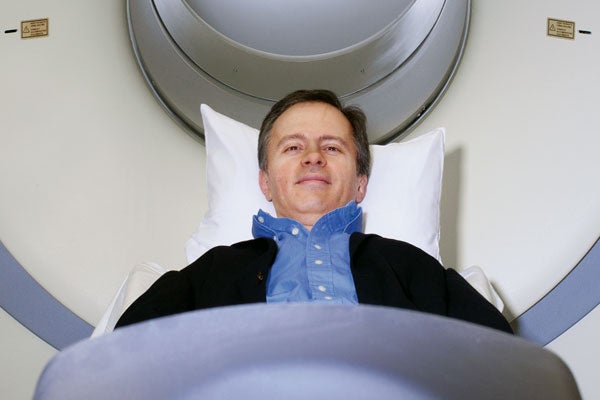
Understanding the depressed mind: how the brains of new mothers may hold the keys to treatment
Published: August 15, 2014
The death of award-winning actor and comedian Robin Williams has put depression and mental health issues back in the headlines.
Scientist Jeffrey Meyer of the University of Toronto and CAMH conducts research into depression and the brain. In this profile from Edge, a publication of U of T's Office of the Vice-President, Research and Innovation, Meyer discusses his research into the role of an enzyme called MAO-A and his work to devise interventions that would help prevent depression in anyone from new mothers to the general population.
Depression is a disorder of many names. Winston Churchill, for example, called his depressive episodes the “black dog.” Others, meanwhile, refer to the condition as the blues or the blahs. Despite the colloquialisms for depression, the reality is the disease can feel like a dark, endless tunnel — one that researcher Jeffrey Meyer hopes to prevent people from entering.
Meyer, an MD/PhD and professor in the University of Toronto’s departments of Psychiatry, and Pharmacology and Toxicology, is head of neurochemical imaging for the Mood and Anxiety Disorders program at the Centre for Addiction and Mental Health (CAMH). Also the Canada Research Chair in Neurochemistry of Major Depressive Disorder, Meyer is focused on answering one question: what is needed to have a healthy brain?
To that end, Meyer wants to create specific recommendations to help people sidestep major depressive disorder. Typically just called depression, the condition is much more than a brief period of melancholy — it involves ongoing feelings of deep despair.
“Ultimately, we would like to say, ‘Here are four things you should do to avoid depression',” Meyer said. “It would be similar to the strategies for avoiding heart disease, which include eating right and exercising, but in the case of depression, the strategies would be more complicated than simply saying ‘avoid stress'.”
That advice could have a significant impact on mental health worldwide. Indeed, depression affects more than 350 million people globally, according to the World Health Organization. While there are treatments for the condition, such as medicine, therapy and lifestyle changes, they don’t seem to work for everyone. And at its worst, depression can lead to suicide. In fact, one million people take their own lives each year around the world.
So what happens in depressed brains? Meyer is focused on monoamine oxidase A (MAO-A), an enzyme that breaks down the chemical messengers serotonin, dopamine and norepinephrine. When the brain is depleted of those mood-related substances, people experience a sad emotional state. And those feelings, along with pessimism, are harbingers of depression.
Although scientists long believed that a chemical imbalance in the brain caused depression, in 2006 Meyer and his colleagues determined conclusively how that process actually works. Using a brain imaging technique called positron emission tomography, the researchers found that the level of MAO-A was considerably higher in the brains of those with untreated depression. Meyer subsequently made other landmark discoveries. For instance, he found that MAO-A is elevated in several high-risk states for clinical depression, including prior to the condition’s recurrence, during early withdrawal from heavy cigarette smoking and just after childbirth.
Today, Meyer is using that information to study and assist those with high MAO-A. For example, he has developed a natural health product to help regulate the MAO-A of new mothers with postpartum depression. After giving birth, a woman’s estrogen level drops considerably, triggering a surge in MAO-A level.
It would still be a few years before the product might reach the market. Meyer is now testing the dietary supplement on new mothers in an open trial (where all patients receive the supplement) and the next step would be to test the product in a randomized, double-blind trial.
Meyer also aims to develop interventions to adjust the MAO-A of people at increased risk of depressive symptoms, including premenopausal women and those with substance addiction. As well, on top of designing preventive strategies to help the general population avoid depression, Meyer hopes to bring peace of mind to those with the treatment-resistant form of the disorder. That two-step process will involve identifying subtypes of depression and determining which treatments best normalize brain changes in each subtype.



